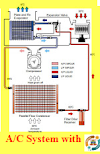Automotive
Air Conditioning
Principles of Air Conditioning
Air Conditioning
Principles of Air Conditioning
High pressure side:
Low pressure R134a vapor entering the compressor is compressed to become high
pressure/temperature R134a vapor. This is then circulated along with lubricant oil to the
condenser. As the high pressure/temperature vapor travels through the condenser, heat is
released to the cooler ambient air passing over the condenser tubes condensing the vapor into a liquid. This high pressure/temperature liquid then travels through the filter drier onto the expansion valve where a small variable orifice provides a restriction against which compressor pushes.
Low pressure side:
Suction from the compressor pulls the high pressure/temperature liquid R134a through
small variable orifice of the TX valve and into the low-pressure side of the A/C system.
The R134a is now under low pressure/temperature vapor where heat from the cabin being blown over the evaporator coil surface is absorbed into the colder low pressure refrigerant The R134a is then pulled through the evaporator and into the compressor. The A/C cycle begins again as the R134a vapor is compressed and discharged under pressure.
R134a in the LOW-PRESSURE side is COLD and can absorb large quantities of heat from
the air moving over the evaporator. R134a in HIGH-PRESSURE side is HOT and the cooler ambient air moving over thecondenser can absorb the heat from it.
Summary:
- When the R134a pressure is low, the R134a temperature is low.
- When the R134a pressure is high, the R134a temperature is high.
kandi younes
abo bahaaeddine


















Really great blog. Can’t believe I haven’t found this before.
ردحذفHeating and Cooling Mississauga
Heating and Cooling East York